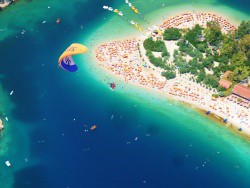Pamukkale - TURKEY

Pamukkale, meaning "cotton castle" in Turkish, is a natural site in Denizli Province in south-western Turkey. The city contains hot springs and travertines, terraces of carbonate minerals left by the flowing water. It is located in Turkey's Inner Aegean region, in the River Menderes valley, which has a temperate climate for most of the year.
The ancient city of Hierapolis was built on top of the white "castle" which is in total about 2,700 metres (8,860 ft) long, 600 m (1,970 ft) wide and 160 m (525 ft) high. It can be seen from the hills on the opposite side of the valley in the town of Denizli, 20 km away.
Tourism is and has been a major industry. People have bathed in its pools for thousands of years. As recently as the mid 20th century, hotels were built over the ruins of Heropolis, causing considerable damage. An approach road was built from the valley over the terraces, and motor bikes were allowed to go up and down the slopes. When the area was declared a world heritage site, the hotels were demolished and the road removed and replaced with artificial pools. Wearing shoes in the water is prohibited to protect the deposits.
MORE
Pamukkale - Hierapolis - TURKEY
Hierapolis (Greek: Ἱεράπολις 'holy city') was the ancient Greek city on top of hot springs located in south western Turkey near Denizli.
Hierapolis is a UNESCO World Heritage Site. The hot springs there have been used as a spa since the 2nd century BCE, and people came to soothe their ailments, with many of them retiring or dying here. The large necropolis is filled with sarcophagi, including the Sarcophagus of Marcus Aurelius Ammianos.
The great baths were constructed with huge stone blocks without the use of cement, and consisted of various closed or open sections linked together. There are deep niches in the inner section of the bath, library, gymnasium and other closed or open locations. The complex, which was constructed in the 2nd century BCE, constitutes a good example of vault type architecture. The complex is now an archaeological museum.
MORE
Recent Comments
Copyright © B Tube Template.












